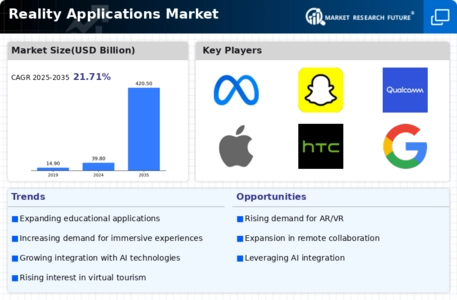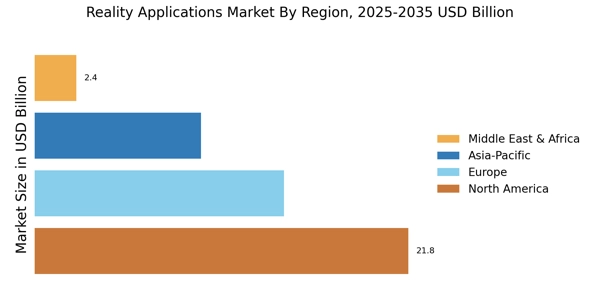Rising Demand for Immersive Experiences
The Reality Applications Market is witnessing a notable increase in demand for immersive experiences across various sectors. As consumers seek more engaging and interactive content, industries such as entertainment, education, and tourism are adopting reality applications to enhance user experiences. According to recent data, the market for augmented reality (AR) and virtual reality (VR) is projected to reach USD 300 billion by 2025, indicating a robust growth trajectory. This demand is driven by advancements in technology, which allow for more realistic simulations and interactions. Consequently, businesses are investing in reality applications to differentiate themselves in a competitive landscape, thereby propelling the Reality Applications Market forward.
Growing Adoption in Education and Training
The adoption of reality applications in education and training is rapidly transforming the Reality Applications Market. Educational institutions and corporate training programs are increasingly utilizing AR and VR technologies to create immersive learning environments. This approach not only enhances engagement but also improves knowledge retention among learners. Recent studies indicate that immersive learning can increase retention rates by up to 75%. As educational institutions recognize the benefits of these technologies, investments in reality applications are expected to rise. This trend is likely to expand the market, as more organizations seek to leverage innovative solutions to enhance their training methodologies and educational offerings.
Expansion of E-commerce and Retail Applications
The expansion of e-commerce and retail applications is significantly influencing the Reality Applications Market. Retailers are increasingly integrating AR and VR technologies to enhance the shopping experience, allowing customers to visualize products in their own environments before making a purchase. This trend is supported by data indicating that 61% of consumers prefer retailers that offer augmented reality experiences. As e-commerce continues to grow, the demand for reality applications that facilitate virtual try-ons and interactive product displays is likely to increase. This shift not only improves customer satisfaction but also drives sales, thereby contributing to the overall growth of the Reality Applications Market.
Increased Investment in Research and Development
Investment in research and development (R&D) is a driving force behind the growth of the Reality Applications Market. Companies are allocating substantial resources to explore new applications and improve existing technologies. This focus on R&D is evident in the rising number of patents filed in the reality applications domain, indicating a competitive landscape where innovation is paramount. Furthermore, government initiatives aimed at fostering technological advancements contribute to this trend. As organizations strive to stay ahead, the emphasis on R&D is likely to yield novel applications that could redefine user interactions and experiences, thereby enhancing the overall market landscape.
Technological Advancements in Hardware and Software
Technological advancements play a crucial role in the evolution of the Reality Applications Market. Innovations in hardware, such as improved headsets and sensors, alongside software developments, enhance the functionality and accessibility of reality applications. The introduction of 5G technology is particularly noteworthy, as it enables faster data transmission and lower latency, which are essential for seamless user experiences. As a result, the market is expected to grow significantly, with estimates suggesting a compound annual growth rate (CAGR) of over 30% in the coming years. These advancements not only improve user engagement but also expand the potential applications of reality technologies across various sectors, including gaming, training, and marketing.


















Leave a Comment